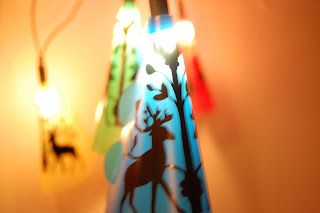
OH MY DEER! PARTY LIGHTS! FLAT PACKED! AMAZING!
The receiver opens the C4 envelope to find these colourful and delightfully whimsy light covers that are fun and simple to assemble. They have the ability to fit over any standard fairy lights and come in a variety of colours that can be changed to suit any theme, i.e. red and green for Christmas.
The idea behind these party light covers stemmed from Mexican celebration decorations known as 'papel picado'. These elaborate decorative pieces are hung up for fiestas, usually for Christmas, Easter, weddings, and christen
ings. I had the idea to take party decorations to a different level and incorporate both party lights and papel picado in one. The light covers serve the purpose of both a party decoration and gift. The decision to embellish the covers with a more traditional American folk art design was made to bridge the gap between Mexican and American folk art, making it open to a wider market.
They make a fun and interactive gift for people of all ages. Assembly is easy as the cover is folded around and slotted together using the tabs.

Made from 0.6mm polypropylene, with the design adhered with black contact, they are able to be kept for a long period of time. Polypropylene was chosen as the sheet material for its properties; it is fairly low cost, is tough and durable, has good resistance to fatigue, and won't melt under low energy light bulbs. As the design is fixed by adhesive contact, it can be changed to give it a fresh new look as the recipient desires.

Peer comments:


